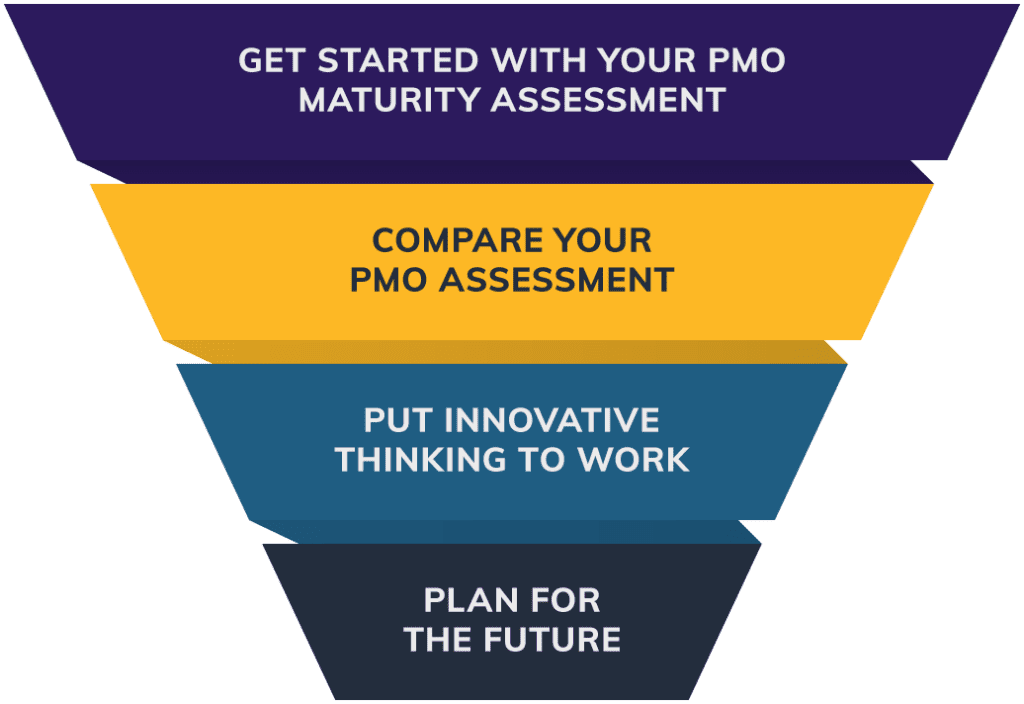Establishing your program management office (PMO) isn’t a one-and-done event. The best way to ensure it delivers value for your company is to perform a PMO maturity assessment every few years. In this blog post, we walk you through how you can assess your PMO.
In brief:
- Assess your current PMO structure and effectiveness through one-on-one interviews with stakeholders, artifact reviews, and evaluations of portfolio processes to identify value gaps and opportunities for improvement.
- Compare your PMO against industry models to benchmark performance and identify innovation opportunities tailored to your organization’s specific needs.
- Develop an actionable roadmap with clear priorities, flexible timing, and value-driven outcomes that bridge the gap between your current state and desired future state.
- Establish meaningful KPIs that directly connect your PMO’s activities to strategic business objectives and conduct regular reviews to optimize value delivery.
- Plan for implementation challenges such as to ensure the successful transformation of your PMO.
Does it feel like your program management office (PMO) isn’t providing the value it should? Are you struggling with too much bureaucracy? Is the department not embracing agile concepts sufficiently? Are you feeling pushback from business groups and executive leadership? It might be time for a PMO maturity assessment.
A PMO refresh is appropriate for many organizations as companies grow and shift focus. It can be difficult to succeed internally at times because the space continually evolves. PMOs are not a one-size-fits-all solution. Your company must evaluate and tailor your PMO to best serve the organization and business units through change.
As Centric Consulting’s Craig Horgan explains, “A culture that embraces change and encourages flexibility and adaptability is essential. PMO leaders must lead change initiatives effectively, and the organization’s culture should foster this effort.”
Now, more than ever, we’re seeing organizations reevaluating the current state of their PMO. They are asking questions like:
- Is it just overhead?
- Does it provide any value?
- Can the organization’s agile, product, and business groups run their own projects?
- Can departments manage their own portfolios?
- Are PMOs a thing of the past?
- Was an enterprise PMO ever a good idea? Is it now?
If you ask any of these questions, it might be a good time to do a program management office maturity assessment.
Gartner’s 2025 Strategic Roadmap for the PMO states that “77% of PMOs are currently operating in multimethodology environments, yet many struggle to establish themselves as trusted partners in value delivery. This is because enterprises demand flexibility that enables more informed business investments, while domain leaders want continuous delivery, value creation and proactive insights.”
A PMO maturity assessment with an outside-looking-in perspective can help you identify gaps between your capabilities and create benchmarks for best practices. What may have once seemed like the right structure, scope, and outputs for your PMO may no longer provide optimal value for your organization.
To maximize the results of your assessment initiative, you need to:
- Get started assessing your PMO
- Compare your PMO assessment
- Plan for the future
Let’s explore each of those steps.
Get Started With Your PMO Maturity Assessment
Begin your PMO assessment by evaluating and documenting your existing PMO and peripheral functions alongside your portfolio manager and senior management. This would include:
- Project delivery and execution enhancements
- The structure of your PMO
- The purpose of your PMO
- Portfolio management practices, which are a set of criteria to aid in your company’s prioritization
Theory and hearsay aren’t enough, and surveys alone don’t reveal all the facts, perceptions, and emotions present. Spend time conducting one-on-one interviews with your business partners, IT teammates, and project managers to reveal more information. Customize questions by role, alignment, and function to reveal succinct data points you can use to paint a picture of the current state.
To further focus on that picture, add a review of existing artifacts and project outputs. Other areas to consider are enterprise elements, speaking with business leaders and employees, and assessing your portfolio processes.
During these discussions, it’s important to foster genuine engagement and a sense of teamwork. As Horgan puts it, this “goes beyond merely giving lip service to PMO stakeholders. Instead, the team actively works in partnership with them to prioritize and deliver high-value projects.”
Compare Your PMO Assessment
Once you gather information about your PMO’s current state, compare your findings to Gartner and other industry PMO capability models.
As you perform your PMO maturity assessment, you’ll find that PMOs are not one-size-fits-all, so use your findings to determine what works for your organization.
When you assess your capabilities against these models and other emerging trends in PMO operations, you and your team can create an ideal future state or options for several potential future states.
Why Compare PMO Models?
Comparing PMO models lets you evaluate your program in the context of industry standard models.
For example, by comparing your PMO model against external models, you benefit from deep research by project management experts. You may also learn about technologies that can augment your PMO initiatives, specifically ones used in other leading models.
What Are the Signs of an Immature and a Mature PMO?
The symptoms of an immature PMO can be tough to spot at first, especially if projects are getting completed according to requirements and the organization is growing.
Here are some red flags to look out for:
- Poor communication between the PMO and stakeholders. This often rears its head in the form of misunderstandings and conflicts around project requirements.
- Limited data-powered decision-making. People may rely on intuition or anecdotal evidence to make decisions instead of dependable business data.
- A disconnect between the PMO and the value it brings to the organization. An immature PMO hasn’t built a case supporting the efficiency and quality improvements it brings to the business.
- Persistent resistance to PMO initiatives. This is often due to a lack of trust on the part of people who don’t yet “believe in” the capabilities of the PMO. They need concrete, demonstrable evidence to convince them.
On the other hand, a strong, mature PMO:
- Excels at communication with stakeholders, which eliminates tense miscommunications
- Uses data to drive all of its decisions and project strategies
- Has clearly demonstrated to all stakeholders the value it brings to the organization
- Has the trust and partnership of stakeholders across the company after consistently delivering effective results
Put Innovative Thinking to Work
Often, establishing the ideal future state depends on taking an innovative approach.
For example, my colleague Cheryl Strait recommends intersecting your PMO with your enterprise change management office (CMO). She highlights a specific use case:
“Recently, at a Fortune 500 financial services company, their PMO engaged with their CMO team to mitigate a visibility gap. Quarterly, their product services department and IT generated a list of priority deployments. However, the CMO had capacity constraints and could not meet the training content requirements within the deployment time frame.
“The PMO collaborated with the product services department and IT to obtain a list of feature releases ahead of quarterly planning sessions. Once received, the PMO then engaged with the CMO to conduct a change impact assessment on each feature, capturing low, medium and high change impacts. As a result, this effort translated into sufficient lead time visibility to plan for training content build.
“This revised process helped them prioritize deployment to meet the CMO timeline. The pairing of the PMO and CMO teams proved successful, resulting in a repeat of the process each quarter going forward.”
By collaborating with the CMO, the PMO was able to add more “flesh” to its assessment and incorporate change impacts, making its future state more feasible.
Plan for the Future
After you decide on your ideal future state, it’s time to put pen to paper and develop a road map that will bridge the identified gaps between your current and future states.
Without this step, any PMO’s process lacks maturity and may end up being symbolic, lacking material value. As you make your plan, you should prioritize activities, clarify how to adopt new processes and tools, and include the value you expect to achieve along the way.
A good road map for a PMO maturity assessment is actionable with succinct tasks, flexible timing, and value-add outcomes. Outcomes that add value can help ensure organizational alignment.
As you emphasize delivering value, remember these two essential things:
- You need to establish key performance indicators (KPIs) and metrics that link program and project outcomes to the organization’s strategic objectives. For instance, you can use KPIs such as on-time project delivery rate, on-budget delivery rate, and the return on investment (ROI) of the entire PMO project portfolio.
- You must regularly review these metrics to gauge progress and make informed decisions to optimize value delivery. These reviews should happen weekly for individual projects and monthly for your entire portfolio of live projects.
This may seem daunting and complicated at first, but it can be helpful to bucket actions into quick hits, short term, and long term. You can rapidly and immediately complete a quick hit and start to provide a benefit. These quick hits may not be the highest priority or ROI efforts, but quickly seeing progress can help the effort gain traction and acceptance in the organization.
Short-term and long-term actions may be wider-reaching and require more runway to implement.
Challenges You May Encounter While Running Your PMO Maturity Assessment
It’s good to understand the obstacles you may face while running your assessment so you can strategize ways to sidestep them. Some challenges include:
- Trouble collecting actionable data. It may take time to establish evaluation metrics that provide an accurate reflection of your PMO’s performance. Conversations with your team and other stakeholders can surface the kinds of data you should focus on, such as project success rates and meeting budgetary goals.
- Resistance to the assessment process from internal stakeholders. Working in a PMO can be taxing, and some may push back against having their performance evaluated. You can assure them it’s a learning experience designed to improve the office’s performance.
- Difficulty implementing changes. Implementing changes may require systemic adjustments, embracing new technologies, or enlisting the expertise of PMO consultants. These can seem daunting at first, but the end results often justify the effort or investment.
Assess Your PMO to Maximize Value
Taking time to assess your PMO and define your desired future state enables you to make the case for the changes that will ultimately result in a better PMO.
Your PMO maturity assessment and plan for the future can improve staff job satisfaction and career pathing. It can increase internal customer delivery results and reporting visibility.
Assessing your PMO’s maturity also gives you the ability to cancel projects if the value isn’t proven out and a better method for portfolio management — so your PMO can work on the right projects at the right time.
Establishing or reevaluating your PMO so your project prioritization is just right can be a tricky business. Our Enterprise Portfolio and Program Management experts will happily work with you to determine your organization’s next steps for moving forward. Let’s Talk




